Biology
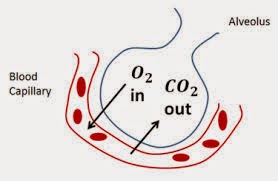 All organisms take in gases from their environment and release gases to the environment. Animals take in O2 for aerobic respiration and release CO2. Plants also respire, but during daylight hours they photosynthesise at a greater rate than they respire, and so take in CO2 and release O2.
All organisms take in gases from their environment and release gases to the environment. Animals take in O2 for aerobic respiration and release CO2. Plants also respire, but during daylight hours they photosynthesise at a greater rate than they respire, and so take in CO2 and release O2.
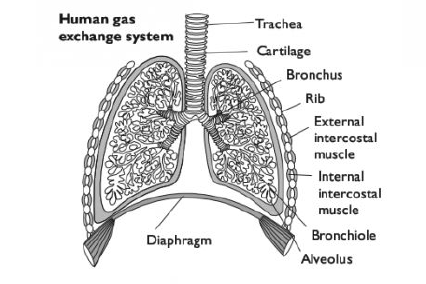

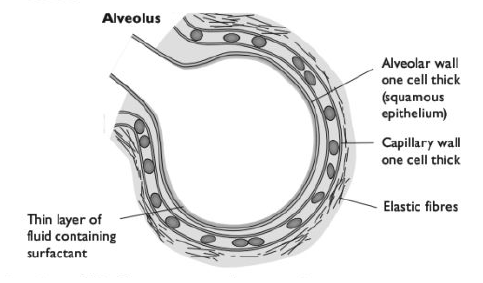
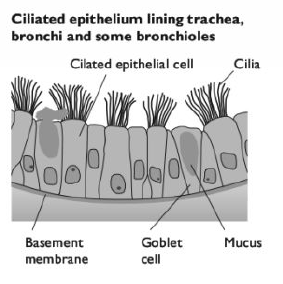
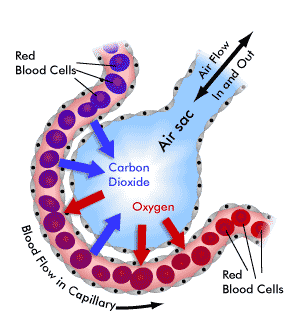
The diffusion gradients for these gases are maintained by:
? breathing movements, which draw air from outside the body into the lungs, and then push it out again; this maintains a relatively high concentration of O2 and low concentration of CO2 in the alveoli;
? blood flow past the alveolus, which brings deoxygenated blood and carries away
oxygenated blood.
Tidal volume and vital capacity
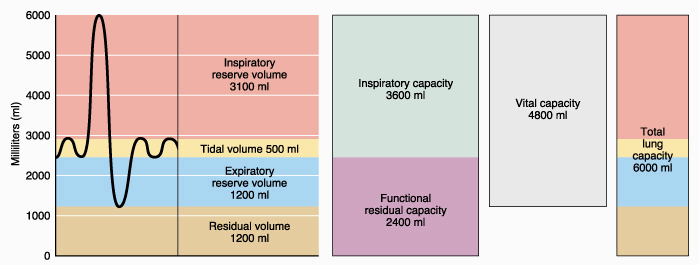
Air moves by mass flow into and out of the lungs during breathing. This is caused by the contraction and relaxation of external intercostal muscles and muscles in the diaphragm. When these contract, they increase the volume of the thoracic cavity and draw air down through the trachea and into the bronchi and bronchioles. When they relax, the thoracic volume decreases and air flows out, down a pressure gradient.
The volume of air that is moved into or out of the lungs during one breath is called the tidal volume. It is generally about 0,5 dm3. The maximum amount of air that can be moved in or out during the deepest possible breath is called the vital capacity. It is generally somewhere between 3 dm3 and 5 dm3.
- #82 Question 5
The diagram below shows a small part of a human lung as it appears through a microscope. (a) Name the type of blood vessel in which the red blood cell is present. (1 mark)(b) Describe and explain two ways in which the structure of the alveoli, shown...
- #51 Summary Of Gas Exchange
1 Multicellular organisms often have surfaces that are specialised to allow exchange of gases to take place between their bodies and the environment. Alveoli in the lungs form the gas exchange surface in mammals. 2 In the human...
- #49.1 Gas Exchange And Smoking Syllabus 2015
? The gas exchange system ? Smoking and smoking-related diseases Learning Outcomes Candidates should be able to: (a) [PA] describe the structure of the human gas exchange system, including the microscopic structure of the walls of the trachea,...
- Breathing And Exchange Of Gases
Click here for PDFRespiration is the oxidation of nutrients in the living cells to release energy for biological work. Breathing is the exchange of O2 from the atmosphere with CO2 produced by the cells. Respiratory organs· General...
- Respiratory System.
Respiratory System.The cells of our body consume oxygen in order to obtain energy. In this process, called oxidation, the cells burn glucose using oxygen, releasing carbon dioxide, and obtaining the necessary energy to carry out several metabolic processes....
Biology
#50 The gas exchange system
 All organisms take in gases from their environment and release gases to the environment. Animals take in O2 for aerobic respiration and release CO2. Plants also respire, but during daylight hours they photosynthesise at a greater rate than they respire, and so take in CO2 and release O2.
All organisms take in gases from their environment and release gases to the environment. Animals take in O2 for aerobic respiration and release CO2. Plants also respire, but during daylight hours they photosynthesise at a greater rate than they respire, and so take in CO2 and release O2.The body surface across which these gases diffuse into and out of the body is called the gas exchange surface. In mammals, including humans, the gas exchange surface is the surface of the alveoli in the lungs.
The human gas exchange system
The gas exchange surface in the lungs is extensive, very thin, well supplied with blood and well ventilated. The trachea and bronchi provide little resistance to the movement of air to and from the alveoli.
- The gross structure of the human gas exchange system

- Plan diagrams of the structure of the walls of the trachea, bronchi, bronchioles



Cartilage in the walls of the trachea and bronchi provides support and prevents the
tubes collapsing when the air pressure inside them is low.
Cillated epithelium is found lining the trachea, bronchi and some bronchioles. It
is a single layer of cells whose outer surfaces are covered with many thin extensions
(cilia) which are able to move. They sweep mucus upwards towards the mouth,
helping to prevent dust particles and bacteria reaching the lungs.
Goblet cells are also found in the ciliated epithelium. They secrete mucus, which
traps dust particles and bacteria.
Smooth muscle cells are found in the walls of the trachea, bronchi and bronchioles.
This type of muscle can contract slowly but for long periods without tiring. When it
contracts, it reduces the diameter of the tubes. During exercise it relaxes, widening
the tubes so more air can reach the lungs.
Elasticc fibres are found in the walls of all tubes and between the alveoli. When
breathing in, these fibres stretch to allow the alveoli and airways to expand. When
breathing out, they recoil, helping to reduce the volume of alveoli and expel air out
of the lungs.
Gas exchange at the alveolar surface
The air inside an alveolus contains a higher concentration of O2, and a lower concentration of CO2, than the blood in the capillaries. This blood has been brought to the lungs in the pulmonary artery, which carries deoxygenated blood from the heart. O2therefore diffuses from the alveolus into the blood capillary, through the thin walls of the alveolus and the capillary. CO2 diffuses from the capillary into the blood.

? breathing movements, which draw air from outside the body into the lungs, and then push it out again; this maintains a relatively high concentration of O2 and low concentration of CO2 in the alveoli;
? blood flow past the alveolus, which brings deoxygenated blood and carries away
oxygenated blood.
Tidal volume and vital capacity

The volume of air that is moved into or out of the lungs during one breath is called the tidal volume. It is generally about 0,5 dm3. The maximum amount of air that can be moved in or out during the deepest possible breath is called the vital capacity. It is generally somewhere between 3 dm3 and 5 dm3.
| Syllabus 2015 (a) [PA] describe the structure of the human gas exchange system, including the microscopic structure of the walls of the trachea, bronchioles and alveoli with their associated blood vessels; (b) [PA] describe the distribution of cartilage, ciliated epithelium, goblet cells and smooth muscle in the trachea, bronchi and bronchioles; (c) describe the functions of cartilage, cilia, goblet cells, mucous glands, smooth muscle and elastic fibres in the gas exchange system; (d) describe the process of gas exchange between air in the alveoli and the blood; |
Syllabus: The gas exchange system is responsible for the uptake of oxygen into the blood and excreting carbon dioxide. An understanding of this system shows how cells, tissues and organs function together to exchange these gases between the blood and the environment. The health of this system and of the cardiovascular system is put at risk by smoking. 9.1 The gas exchange system The gas exchange surface in the lungs is extensive, very thin, well supplied with blood and well ventilated. The trachea and bronchi provide little resistance to the movement of air to and from the alveoli. a) describe the gross structure of the human gas exchange system b) observe and draw plan diagrams of the structure of the walls of the trachea, bronchi, bronchioles and alveoli indicating the distribution of cartilage, ciliated epithelium, goblet cells, smooth muscle, squamous epithelium and blood vessels c) describe the functions of cartilage, cilia, goblet cells, mucous glands, smooth muscle and elastic fibres and recognise these cells and tissues in prepared slides, photomicrographs and electron micrographs of the gas exchange system d) describe the process of gas exchange between air in the alveoli and the blood |
- #82 Question 5
The diagram below shows a small part of a human lung as it appears through a microscope. (a) Name the type of blood vessel in which the red blood cell is present. (1 mark)(b) Describe and explain two ways in which the structure of the alveoli, shown...
- #51 Summary Of Gas Exchange
1 Multicellular organisms often have surfaces that are specialised to allow exchange of gases to take place between their bodies and the environment. Alveoli in the lungs form the gas exchange surface in mammals. 2 In the human...
- #49.1 Gas Exchange And Smoking Syllabus 2015
? The gas exchange system ? Smoking and smoking-related diseases Learning Outcomes Candidates should be able to: (a) [PA] describe the structure of the human gas exchange system, including the microscopic structure of the walls of the trachea,...
- Breathing And Exchange Of Gases
Click here for PDFRespiration is the oxidation of nutrients in the living cells to release energy for biological work. Breathing is the exchange of O2 from the atmosphere with CO2 produced by the cells. Respiratory organs· General...
- Respiratory System.
Respiratory System.The cells of our body consume oxygen in order to obtain energy. In this process, called oxidation, the cells burn glucose using oxygen, releasing carbon dioxide, and obtaining the necessary energy to carry out several metabolic processes....
